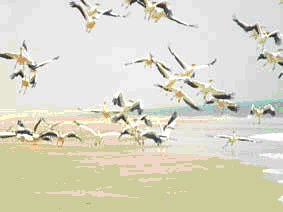Banc d'Arguin is a World Heritage Site and was established as a National Park in Mauritania in 1976. It is located on the western fringe of the Sahara, and accounts for more than one third of Mauritania’s entire coastline. It is one of the richest fishing grounds in the world, owing to the upwelling of cold, nutrient-rich waters.
The park’s has an area of 1,200,00 ha which includes marine, land areas and islands. The wetlands are composed of extensive, shallow marine areas, scattered islands, intertidal sand banks, mudflats, channels, creeks and mangrove forest. The mudflats support vast beds of seagrass housing mollusks and crustaceans and are important high-tide feeding or nursery areas for commercially-important deep sea fish.
Banc d’Arguin was designated a Ramsar Wetland of International Importance in 1982. The Park is home to 1500 fishermen and their families who use traditional fishing methods for a livelihood.
Large flocks of shorebirds forage at low tide and over two million flock to the park’s mudflats between September and March.. It is home to more than 40,000 pairs of nesting birds including several species of terns, cormorants, pink flamingos, endemic grey herons, endemic spoonbills, white pelicans, slender bill gulls.
Other notable fauna include a variety of marine mammals, marine turtles, and an endangered seal species. The marine life includes fishes, marine mammals and sea turtles, shellfish.
Salt tolerant grasses grow along the coast, and in the desert are typical Saharan plants, bushes and trees. Plants include more than 200 species.
Drought and poaching have almost eradicated the larger mammal species (Oryx, Gazelles, Ostriches). Desert rodents and reptiles are seasonal visitors. There is a small population of Dorcas Gazelles on Tidra Island.
Barc d’Arguin National Park was inscribed in 1989 as UNESCO World Heritage Site based on the following UNESO criteria:
1) an outstanding example representing significant on-going ecological and biological processes in the evolution and development of terrestrial, fresh water, coastal and marine ecosystems and communities of plants and animals.
2) contains the most important and significant natural habitats for in-situ conservation of biological diversity, including those containing threatened species of outstanding universal value from the point of view of science and conservation.
The Convention on Wetlands came into force for Mauritania on 22 February 1983. Mauritania presently has 3 sites designated as Wetlands of International Importance, with a surface area of 1,231,100 hectares: Banc d’Arguin, Parc National du Diawling, and Chat Tboul.
Ramsar site no. 250.
Reference: http://www.ramsar.org/profile/profiles_mauritania.htm
photo: http://www.mauritania-today.com/anglais/tourism/banc-d-arguin/


